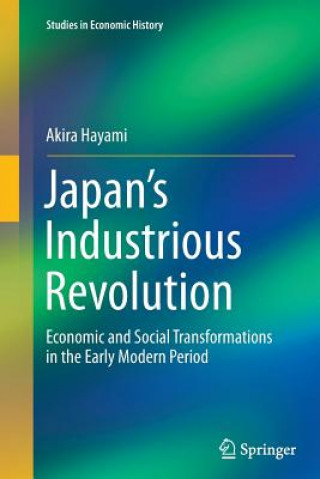
Code: 15224134
Japan's Industrious Revolution
by Akira Hayami
This book explains in fascinating detail how economic and social transformations in pre-1600 Japan led to an industrious revolution in the early modern period and how the fruits of the Industrious Revolution are what have supporte ... more
- Language:
 English
English - Binding: Paperback
- Number of pages: 130
Publisher: Springer Verlag, Japan, 2016
- More about this

You might also like
-

Salisbury
31.79 € -4 % -

Live and Let Live
134.64 € -

Electric Train Energy Consumption Reduction by Passing Stations
53.36 € -

Life is Life
40.68 € -

Tratado del arte de trinchar y modo de servir a una mesa
12.05 € -

Los archivos de The Spirit 12
37.41 € -5 % -

Populares Handbuch des Grasbaus,
36.90 €
Give this book as a present today
- Order book and choose Gift Order.
- We will send you book gift voucher at once. You can give it out to anyone.
- Book will be send to donee, nothing more to care about.
More about Japan's Industrious Revolution
You get 151 loyalty points
 Book synopsis
Book synopsis
This book explains in fascinating detail how economic and social transformations in pre-1600 Japan led to an industrious revolution in the early modern period and how the fruits of the Industrious Revolution are what have supported Japan since the eighteenth century, improving living standards and leading to the formation of the work ethic of modern Japan. The arrival of the Sengoku Period in the sixteenth century saw the emergence and domination of government by the warrior class. It was Tokugawa Ieyasu who unified the realm. Yet this unity did not give rise to an autocratic state, as the shogun was recognized merely as a main pillar of the warrior class. Economically, however, from the fourteenth century, currency payments for sh en nengu (taxes paid to the proprietor) became standard, and currency circulation began, primarily in the central region. Under Tokugawa rule, organized domestic coinage of currency began, opening the way to establishing a national economic society. Also, agricultural land was surveyed through cadastral surveys known as kenchi . Land values were converted in terms of rice, so the expected rice yields for each village were assessed, and the lords used this as a benchmark for imposing taxes. In the sixteenth and seventeenth centuries, Japan experienced a "great transition," and conditions for peasants, agriculture, and farming villages underwent great changes. Inefficient traditional agriculture using peasants in a state of servitude was transformed into highly efficient small-sized farming operations which relied on family labor. As production yields increased due to labor-intensive agriculture, the profits obtained by the peasants improved their living standards. The stem-family system became the norm through which work ethics and even literacy were transmitted. This very change was the result of the "industrious revolution" in Japan. The book thus presents the framework of the facts of pre-industrial Japanese history and depicts pre-modern Japan from a macroscopic point of view, showing how the industrious revolution came about. It is certain to be of great interest to economists and historians alike.
 Book details
Book details
61.13 €
- Full title: Japan's Industrious Revolution
- Subtitle: Economic and Social Transformations in the Early Modern Period
- Author: Akira Hayami
- Language:
 English
English - Binding: Paperback
- Number of pages: 130
- EAN: 9784431564096
- ISBN: 4431564098
- ID: 15224134
- Publisher: Springer Verlag, Japan
- Weight: 2409 g
- Dimensions: 235 × 155 × 8 mm
- Date of publishing: 29. October 2016
Trending among others
-

Dune
10.52 € -14 % -

Haunting Adeline
30.76 € -

Berserk Deluxe Volume 2
52.64 € -

White Nights
3.57 € -24 % -

Powerless
11.95 € -8 % -

Atomic Habits
15.94 € -15 % -

Dune Messiah
8.99 € -20 % -

Berserk Deluxe Volume 3
52.85 € -

One Day
12.57 € -13 % -

Berserk Deluxe Volume 1
48.25 € -5 % -

Iron Flame
16.25 € -19 % -

Surrounded by Idiots
11.75 € -21 % -

Harry Potter and the Prisoner of Azkaban (Minalima Edition)
27.19 € -33 % -

Gravity Falls Journal 3
22.07 € -

Heaven Official's Blessing: Tian Guan Ci Fu (Novel) Vol. 1
21.46 € -

The Creative Act
24.02 € -13 % -

Dune
9.70 € -19 % -

Hunting Adeline
31.79 € -

A Little Life
17.47 € -

Children of Dune
8.78 € -22 % -

Heaven Official's Blessing: Tian Guan Ci Fu (Novel) Vol. 2
18.90 € -9 % -

Bungo Stray Dogs, Vol. 8 (light novel)
16.55 € -

Percy Jackson and the Olympians 5 Book Paperback Boxed Set
43.65 € -5 % -

Solo Leveling, Vol. 1
22.89 € -

The Prisoner's Throne
11.44 € -4 % -

Court of Thorns and Roses
9.29 € -20 % -

Cry Baby Coloring Book
10.93 € -3 % -

Fourth Wing
16.66 € -16 % -

Icebreaker
9.19 € -23 % -

Berserk Deluxe Volume 6
51.11 € -

Avatar, the Last Airbender: The Kyoshi Novels (Box Set)
27.49 € -33 % -

The 48 Laws of Power
26.88 € -1 % -

House of Leaves
23.20 € -4 % -

Twisted Lies
9.80 € -24 % -

Dune Messiah
10.01 € -31 % -

No Longer Human
16.55 € -

48 Laws Of Power
22.59 € -5 % -

Twisted Games
9.80 € -24 % -

Caraval Paperback Boxed Set
39.76 € -8 % -

Solo Leveling, Vol. 2
22.38 € -

Open Circuits
34.45 € -16 % -

Berserk Deluxe Volume 5
51.32 € -

Heaven Official's Blessing: Tian Guan Ci Fu (Novel) Vol. 3
19.72 € -5 % -

Berserk Deluxe Volume 4
51.62 € -

Court of Mist and Fury
10.42 € -13 % -

SOLO LEVELING V08
22.38 € -

English File Upper Intermediate Multipack A (4th)
23.61 € -

CHAINSAW MAN V14
11.24 € -14 % -

Before the Coffee Gets Cold
9.09 € -16 %
Osobný odber Bratislava a 2642 dalších
Copyright ©2008-24 najlacnejsie-knihy.sk Všetky práva vyhradenéSúkromieCookies



 21 miliónov titulov
21 miliónov titulov Vrátenie do mesiaca
Vrátenie do mesiaca 02/210 210 99 (8-15.30h)
02/210 210 99 (8-15.30h)